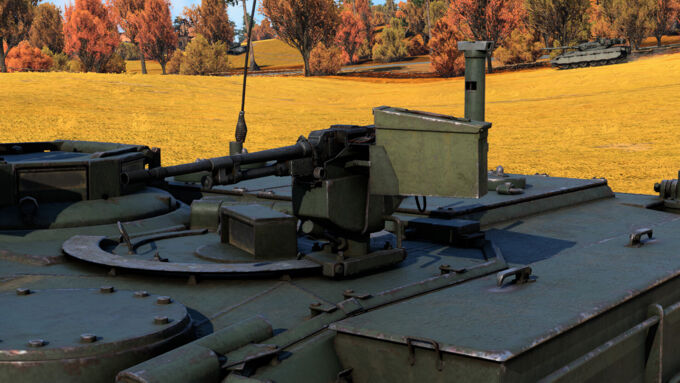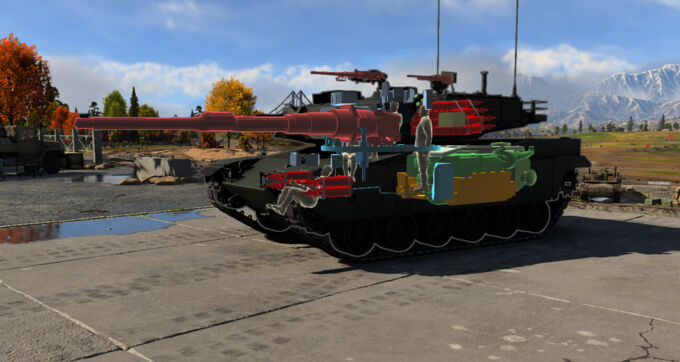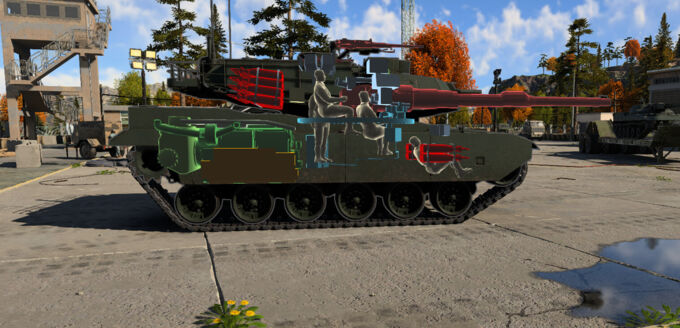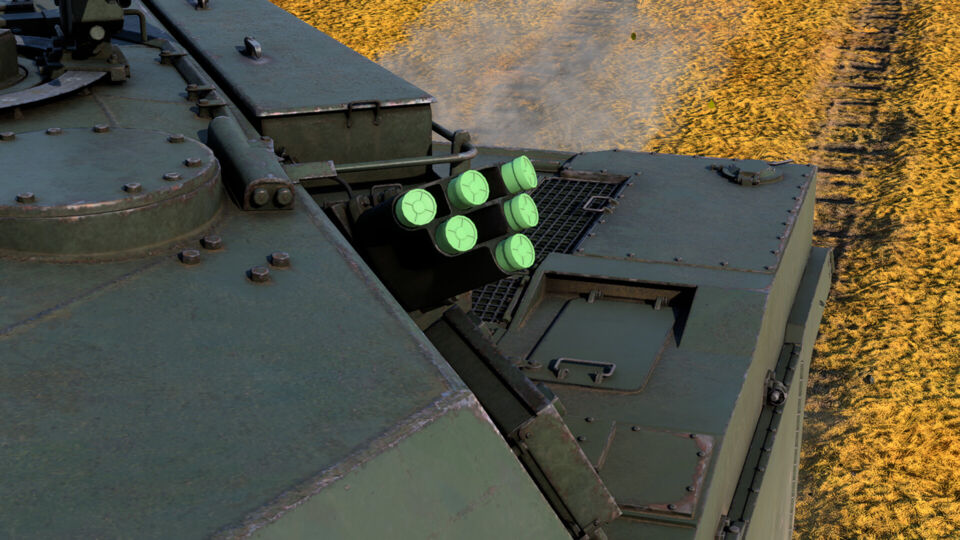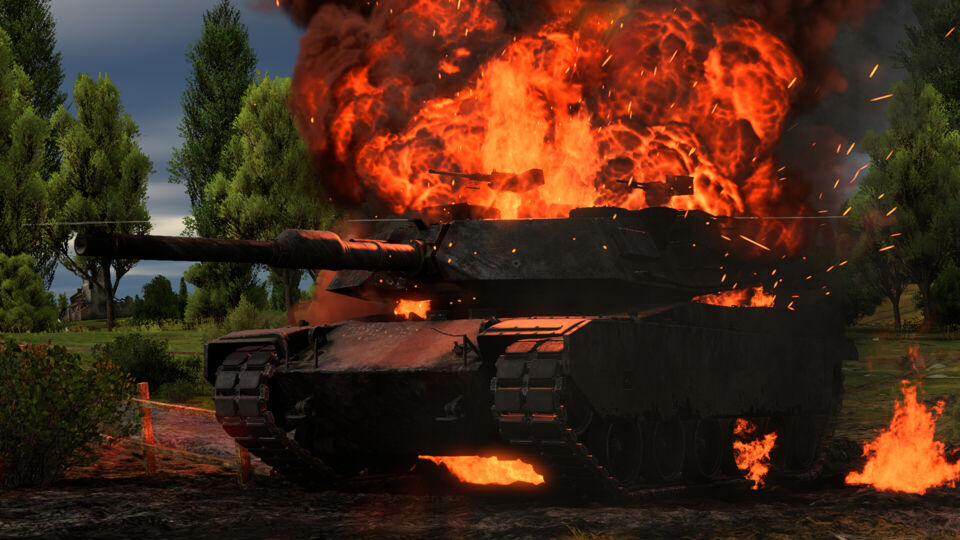The 120S is a modern upgrade built on a M60 hull with a M1A1 turret, marrying legacy design with contemporary firepower. With a powerful 120 mm M256 cannon and enhanced optics, it offers fresh tactical opportunities while retaining the familiar playstyle of its predecessor. Although the hull’s protection and mobility have limitations compared to fully modern designs, the 120S opens up new strategic possibilities on the battlefield.
| Pros: | Cons: |
|---|---|
| Strong Turret: Strong M1A1 armor on the turret and 120mm cannon | Weak Hull: M60 chassis offers poor protection. Not to mention the gap between Hull and Turret. |
| High-Caliber Cannon: M256 offers lethal round options with varying penetration. | Sluggish Movement: Underpowered for its weight. |
| Effective Hull-Down Fighter: Strong turret + gun depression makes it ideal for fighting and using terrain for cover. | High Silhouette: Easy to spot and hit, especially outside cover. |
Armaments
The 120S is armed with a formidable 120 mm M256 cannon, capable of delivering powerful and accurate fire. Its design emphasizes on precision and stabilization, enabling the vehicle to engage targets effectively even while on the move. Backing the main gun are a set of a reliable machine guns: a roof-mounted 12.7 mm M2HB for anti-air and soft targets, and two 7.62 mm M240 machine guns, one coaxial and one roof mounted, ideal for spotting enemies through smoke.
The 120mm M256 Cannon.
The centerpiece of the 120S is its 120 mm M256 cannon, which delivers a high-caliber punch on the battlefield. Equipped with a two-plane stabilizer, the cannon can fire accurately while on the move, making it a formidable tool against enemy armor.
- Reload Time: 6.5 s (basic crew), 5 s (ace crew)
- Vertical Guidance: -10° to +20°
- Turret Rotation Speed (Horizontal): 28°/s → 40°/s
- Turret Rotation Speed (Vertical): 16.8°/s → 24°/s
Available Ammunition
| Ammunition | Type | Tactical Use |
|---|---|---|
| M830 | HEATFS | Ideal for hitting light armor and targets behind cover, like SPAAs or IFVs. It can also bypass (some) ERA, but struggles against spaced armor or higher mm of chemical protection ERA on modern MBTs. |
| M829 | APFSDS | Effective against older Soviet MBTs like T-55AM-1 and T-64A, where frontal penetration is achievable without much aiming finesse. It can struggle, however, against well-armored turret cheeks or angled upper fronts on modern MBTs like the T-80 series. |
| M830A1 | HEAT MP | A versatile choice that allows limited anti-air capability and effective performance against soft and medium armor. Less optimal versus heavily armored targets, but reliable in mixed-target environments. |
| M829A1 | APFSDS | A superior choice when facing top-end tanks such as the Leopard 2A4, Type 90, or T-80B, particularly in head-on engagements. This round offers a higher chance of penetrating composite armor or disabling critical components through more armored sections. |
| M908 | HE-OR | Use this against lightly armored support vehicles, open-topped SPGs, or when obstacles shield your target. |
Secondary Armament
The 120S is fitted with a suite of machine guns for dealing with soft targets and spotting enemies. A 12.7 mm M2HB heavy machine gun sits on the roof, effective against low-flying aircraft and lightly armored vehicles. It's supported by two 7.62 mm M240 machine guns, one coaxial and one roof-mounted, useful for suppressing enemy positions and marking targets through smokes.
Armor and Survivability
The 120S presents a unique blend of protection and vulnerability. Its turret, borrowed from the M1A1 Abrams, with its composite armor, offers solid frontal armor capable of deflecting many kinetic and some chemical energy rounds, giving it a significant edge in hull-down engagements. However, this is offset by the M60 hull beneath, a legacy design with outdated armor that leaves the lower half of the vehicle highly vulnerable to modern threats.
Armor Thickness:
| Front | Side | Rear | |
|---|---|---|---|
| Hull | 108 mm | 70 mm | 40 mm |
| Turret | 230 mm | 49 mm | 57 mm |
The 120S houses a four-man crew, commander, gunner, loader, and driver, spread throughout the large interior. While this spacing slightly reduces the chance of a single shot knocking out the entire crew, a penetrating hit to the hull often disables key components or ignites stored ammunition.
To assist with survivability, the 120S is equipped with:
| Smoke Grenades: | Deployed to obscure enemy sightlines or facilitate retreats |
| Laser Rangefinder: | Enhances long-range accuracy and target acquisition, reducing exposure time during engagements. |
| Thermal Imaging Sight (Gunner Only): | Equipped with Gen 2 thermals, it can help you detect and engage targets through ESS, darkness or light foliage. |
Armor Comparison:
When compared to its contemporaries, such as the Leopard 2A4, T-80B, and Type 90, the 120S falls into an awkward middle ground. The Leopard 2A4 and Type 90 both offer composite armor coverage across their entire hull and turret, significantly reducing vulnerability to modern APFSDS rounds. The T-80B features strong ERA and a low profile, making it harder to target effectively.
In contrast, the 120S has a high profile and offers little to no composite protection on the hull, meaning even light tank rounds or older APFSDS shells can penetrate. While its turret armor is comparable to the M1A1 and can absorb some hits, it isn’t enough to reliably survive direct engagements.
Ultimately, the 120S relies more on its firepower and smart positioning than raw armor. Players must use cover wisely and avoid exposing the hull whenever possible. Especially in close-range fights where enemy rounds are more likely to hit and penetrate the lower chassis.
Mobility
The 120S delivers modest mobility for a main battle tank but is noticeably sluggish compared to more modern MBTs. The added weight from the M1A1 turret, without an upgraded engine, limits acceleration and overall agility. Its power-to-weight ratio is reduced compared to both the M1A1 and late-model M60s, making it slower to reposition and react under fire.
- 48 km/h forward speed
- 11 km/h reverse speed
While it retains the tracked suspension of the M60, the added turret weight slightly hampers responsiveness. The limited reverse speed also makes it harder to disengage quickly after a failed push or when taking incoming fire. It’s important to plan movement in advance and avoid overextending.
Terrain Handling:
The 120S benefits from the classic M60 chassis, which provides solid off-road performance on most terrain types. However, inclines and muddy environments can present challenges due to the weight imbalance from the heavy turret. While it can handle rough terrain better than wheeled vehicles, its slow acceleration and reduced torque under load make it less reliable on steep hills or when performing quick maneuvers.
Mobility Comparison:
In comparison to contemporary tanks, the 120S trails behind its peers in terms of mobility. The Leopard 2A4 and Type 90 both offer superior speed and acceleration, allowing them to quickly react, relocate, or exploit flanks. The T-80B, while heavier, boasts a gas turbine engine that make it more responsive in tight situations (except of course from reversing.)
Compared to these, the 120S struggles to keep pace. It’s not entirely immobile, but it requires more deliberate positioning and map knowledge to stay effective. Avoid fast-paced close-quarters brawls and instead focus on long-range support and hull-down engagements, where mobility plays a smaller role than firepower and turret armor.
Usage in Battle
The 120S is best used as a second-line support tank that delivers heavy firepower from a relatively safe distance. While its M1A1 turret offers excellent protection, the vulnerable M60 hull and underwhelming mobility make it ill-suited for aggressive frontline brawls. Instead, the 120S thrives in hull-down positions and long-range engagements, where it can maximize the firepower of its 120 mm M256 cannon while minimizing exposure.
Success with the 120S comes from positioning. It’s not a tank that forgives overextension, once committed, it struggles to back out. Smart terrain use and map knowledge let you control key sightlines and support allies without exposing the weak points of the vehicle.
While it lacks the full-package survivability of a true M1A1 Abrams, the 120S can punch well above its weight if used with patience and positioning. Rely on its powerful gun and strong turret armor, play smart, pick your fights, and the 120S becomes a reliable battlefield anchor.



